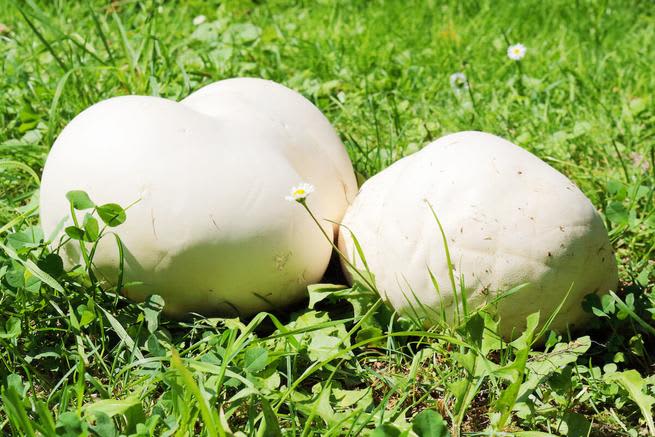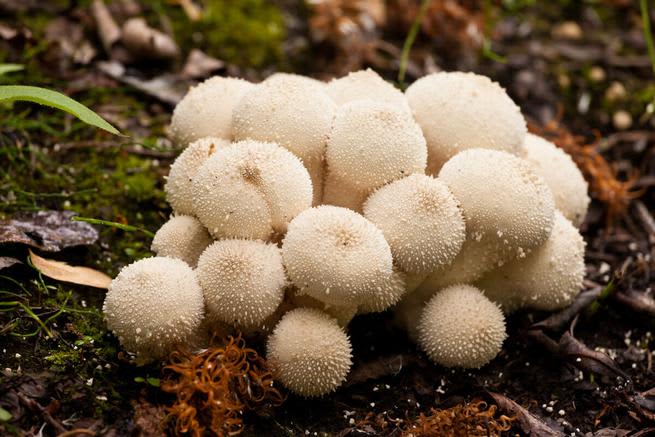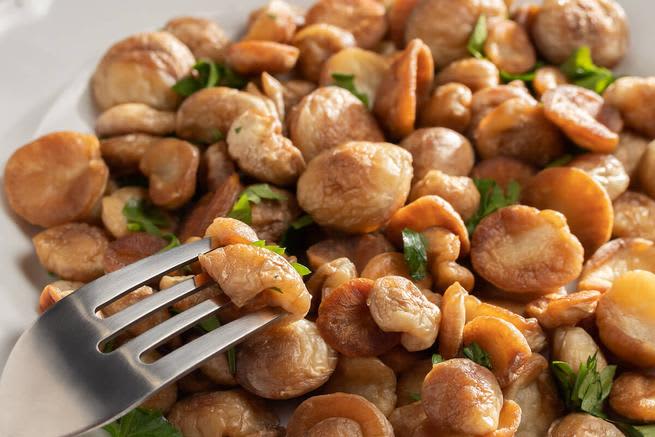You’ve probably stumbled across puffball mushrooms before and didn’t even know it. Sometime during your childhood, these fascinating fungi likely popped up in open areas or a yard, ready to mature and spread their spores.
But what makes these mushrooms so intriguing?
Get the answer to that question (hint: it has to do with their spores) and discover how to identify them, where they grow, and the best way to enjoy them.
What are puffball mushrooms?
Puffball mushrooms are the common name given to three different genera (or genus) of mushroom: calvatia gigantea, lycoperdon, and calbovista—the giant puffball mushroom, puffball mushroom, and sculptured puffball respectively (1).
Only some puffball species are edible mushrooms; some are only edible in early growth stages, while the toxicity of others remains to be determined.
What makes these mushrooms unique is how they disperse their spores and lack some of the typical characteristics associated with mushrooms, such as stems, caps, and gills.
Instead of having spores underneath a mushroom cap, these shrooms produce all of their spores inside the fruiting body. Even more interesting is how they disperse them.
A puffball will disperse its spores similarly to other mushrooms that disperse their spores when they come into contact with rain, a breeze, or animals. Except there’s one key difference: the protective layer inside these mushrooms contain their spores.
Once that layer is broken, puffball spores are ejected through a small opening at the top of the mushroom in a puff—hence the name (2). This characteristic is why puffballs, along with other types of mushrooms, belong to the gasteromycetes group of mushrooms, literally meaning “stomach fungi” (3).
They play an essential role in the environment too. Puffball mushrooms are saprobic, which means they get their nutrients from breaking down organic matter. Think of them as fungal recycling centers for leaves, tree roots, and wood.
Psst: All these mushrooms are in the fungi kingdom, Basidiomycota division, Agaricomycetes class, Agaricales order, and Agaricaceae family. We’ll only spend a little time getting into the specifics of each one; instead, we’ll be referring to puffballs in general unless otherwise specified.
What do puffball mushrooms look like?
There’s a lot of variety with puffball mushrooms. These guys may be as small as a golf ball or, in the case of giant puffball mushrooms, reach sizes comparable to a soccer ball. And while usually round, they can also be pear-shaped.
This means you can expect to see puffball shrooms as small as 1 inch and up to 24 inches across. Mature giant puffballs can even weigh up to 10 pounds (4). Moreover, a giant puffball mushroom can have up to 7 trillion spores (5).
Puffball mushrooms are usually white or light in color. They can have smooth outside skin or skin that’s more lumpy and uneven, similar to a wart. They can even have a texture reminiscent of an artist’s sculpture (1).
These shrooms have white flesh, although as they age and mature, they can turn tan or be a shade closer to olive-brown.
Psst: These mushrooms are firm inside and out; they don’t have an elastic fruiting body like tremella mushrooms. An edible puffball will have firm white flesh throughout, no color variation, and a firm fruiting body.
Where do puffball mushrooms grow?

Puffball mushrooms are a common sight in temperate regions, like Southern England and the Eastern areas of North America, especially during late summer and early fall. They also favor open spaces or meadows and can sometimes grow under trees or other well-fertilized areas (6). Woodlands and wooded gardens are also preferred habitats (7).
Psst: Occasionally, puffball mushrooms may grow in small groups in a pattern known as fairy rings. Sometimes called elf or pixie rings, a fairy ring is fueled by the mycelium growing under the ground (more on this in a bit). They usually get bigger as they get older.
Historical and traditional use of puffball mushrooms
Puffball mushrooms have been used traditionally by Native Americans and in traditional Chinese medicine.
The Native American Lakota tribe benefitted from puffball mushrooms because of all those trillions of spores. They discovered puffball spores acted as a coagulant and used these as part of their wound care to stem bleeding and stave off infection.
These properties caught the attention of researchers in the 1960s, which proved fruitful. Scientists isolated a compound in puffball mushrooms that demonstrated antitumor activity (5).
In Chinese medicine, puffball mushrooms help stop bleeding and soothe sore throats. Eastern medicine values puffball mushrooms for their ability to work on the lung meridian, soothe coughs and hoarseness, and reduce inflammation (8).
Health benefits of puffball mushrooms

Like many other mushrooms, puffball shrooms are filled with nutrients that benefit and support the body.
Giant puffball mushrooms supply essential amino acids like tryptophan, valine, leucine, phenylalanine, and more, along with fiber and polyunsaturated fatty acids.
Modern medicine confirms what the Lakota tribe and traditional Chinese medicine practitioners knew hundreds of years ago. Here are some of the benefits puffball mushrooms offer:
- Immune system support: Compounds in puffball mushrooms, specifically beta-sitosterol and melanin, inhibit the development of inflammatory immune cells. This helps your body reduce inflammation while helping it fight the good fight against disease and infection.
- Blood sugar regulation: Giant puffball mushrooms can reduce the enzyme that increases blood glucose levels. It can not only help prevent diabetes but also act as an ally for the body.
- Antitumor benefits: Remember the research done by scientists in the 1960s? The compound they isolated was used in an animal experiment. Mice with sarcomas (cancer affecting bones and soft tissues) that were given this compound saw a reduction in the size of their tumors (9).
Ethically wildcrafting puffball mushrooms
You might feel more than ready to head out in search of puffball mushrooms. Still, before you jump in with both feet, it’s vital to learn the differences between foraging and ethical wildcrafting mushrooms.
Foraging generally refers to gathering wild food resources found in nature. Conversely, ethical wildcrafting involves harvesting local resources for medicinal needs. While they may seem like synonyms, wildcrafting is more specific and mindful, both in terminology and approach.
Ethically wildcrafting considers more than the wild food being gathered; it keeps the ecology of an area front of mind throughout the process.
Learning about the local environment is essential, including familiarizing yourself with any endangered or threatened species you could find, and any lookalikes you’ll want to avoid. Remember to check local laws around harvesting mushrooms and plants, including securing the appropriate permits if required.
Another critical aspect of wildcrafting involves familiarizing yourself with mushroom anatomy. Most of the time, when we think we’re seeing the whole mushroom, we’re really only seeing the fruiting body, which is only part of the mushroom equation. Just beneath the surface lies the mycelium, a network of delicate filaments called hyphae. Sometimes called the “wood wide web,” mycelium allows plants and fungi to communicate with each other. This sophisticated network makes information about environmental changes, nearby predators, and nutrient exchanges possible.
Responsible harvesting includes minimizing any potential damage to this part of the mushroom, so use the appropriate tools and techniques to harvest your mushrooms. Some are best cut right at the surface, while others may be gently twisted to loosen them from the soil.
Lastly, another cornerstone of ethical wildcrafting involves gathering only what you need. Birds, deer, insects, rodents, and more all enjoy a fungal feast and overharvesting can negatively affect the local environment.
Consider making a spore print from your harvested mushrooms. You’ll be able to use the spores from the print to start growing your own mushrooms at home.
Psst: Mushroom identification is essential with puffball mushrooms. While not all species of amanita mushrooms are toxic, many are downright dangerous, and the destroying angel is no exception. This white mushroom can easily be mistaken for a puffball during some growth stages. Be sure to cut through any puffball mushrooms you harvest from top to bottom and take a peek inside. There shouldn’t be any sign of a cap or stem, and it should have a pure white interior, like a marshmallow (10).
How can you enjoy puffball mushrooms?

Mushrooms are a beautifully versatile kitchen ingredient. We’ve rounded up some of our favorite recipes where puffball mushrooms are the main event or a can’t miss umami-rich addition. Even if you’re a beginner at cooking mushrooms, we’re sure you can pull these off.
Puffball schnitzel
Mushrooms are known for their meaty deliciousness, and what better way to showcase that than with a puffball schnitzel recipe? Don’t let this recipe intimidate you if you’re not a kitchen pro; it’s imminently doable. Sometimes getting the breading to stick can be tricky, but not here. A dip into flour, followed by a bath in a beaten egg, and then a final dip in breadcrumbs create a delicious breading you’ll be proud of. Topped with caramelized onion gravy and fresh sage, this recipe is sure to please everyone at the table.
Puffball mushroom pizza
Puffball pizza? Sign us up. This unconventional pizza crust is far easier to prepare (and more foolproof) than regular pizza dough while still being the perfect canvas for all of your favorite toppings, like mozzarella cheese, pepperoni, sausage, artichokes, you name it. With a mild flavor, you can enjoy your pizza without wondering if the crust will affect the taste of your toppings. Win-win.
Sauteed puffball mushrooms
It’s hard to beat sauteed mushrooms, especially since it’s so easy to adapt a simple saute to whatever types of mushrooms you have on hand—morel mushrooms, chanterelles, maitake, and golden oyster mushrooms are all perfect here. Butter, olive oil, with fresh thyme, and rosemary are a match made in heaven. Skip the stir-fry and try these instead.
Dehydrated puffballs
If you have a bounty of puffball mushrooms but aren’t sure what to do with them, try dehydrating them! Drying your mushrooms removes all the water content and makes them much easier to store for extended periods.
Keep those mushrooms as is, rehydrate them with hot water when needed, or grind them into a powder. Adding a teaspoon here or a teaspoon there of dried puffballs can bring wonderful umami flavor to salad dressings, pasta sauces, and more. All you’ll need is a pinch of salt to round out a meal. And remember to peel off the outer skin before you throw on your apron.
Puffball mushrooms: A shroom with more than meets the eye
Puffball mushrooms are a fascinating member of the fungi family. With a unique reproduction process, an array of health benefits, and plenty of cooking versatility, these are a mushroom worth exploring.
For more mushroom happenings, including news and breakthroughs on medicinal and psychedelic mushrooms, be sure to keep up with us on shroomer.
References
- Mycological Society of San Francisco. “Wild about Mushrooms: Puffballs.” Accessed July 22, 2024. https://www.mssf.org/cookbook/puffballs.html
- Gast, Richard. “In Pursuit of Giant Puffballs, the Queen of Edible Mushrooms: -.” The Adirondack Almanack, September 8, 2020. https://www.adirondackalmanack.com/2020/09/in-pursuit-of-giant-puffballs-the-queen-of-edible-mushrooms.html
- Utah State University. “Earth Stars,” n.d. https://www.usu.edu/herbarium/education/fun-facts-about-fungi/earth-stars
- “Puffballs | Nebraska Extension,” n.d. https://extension.unl.edu/statewide/dodge/puffballs/
- Utah State University. “Giant Puffballs,” n.d. https://www.usu.edu/herbarium/education/fun-facts-about-fungi/giant-puffballs
- American Museum of Natural History. “Giant Puffball Mushroom | AMNH,” n.d. https://www.amnh.org/explore/ology/ology-cards/144-giant-puffball-mushroom
- Iowa State University: Ada Hayden Herbarium. “Calvatia Gigantea (Batsch.) Lloyd: Giant Puffball,” March 6, 2018. Accessed July 21, 2024. https://www.herbarium.iastate.edu/files/fungi/Calvatia%20gigantea%20(Batsch.)%20Lloyd.pdf
- White Rabbit Institute of Healing. “Puffball (Ma Bo),” n.d. https://www.whiterabbitinstituteofhealing.com/herbs/puffball/
- Kunde, Roma. “Health Benefits of Giant Puffball.” WebMD, November 18, 2022. https://www.webmd.com/diet/benefits-of-giant-puffball
- Missouri Department of Conservation. “Giant Puffball,” n.d. https://mdc.mo.gov/discover-nature/field-guide/giant-puffball.







